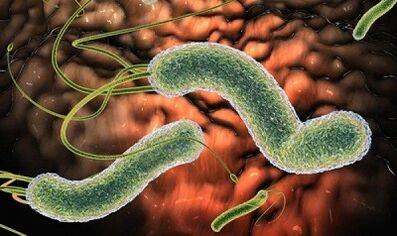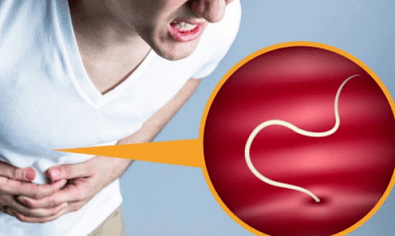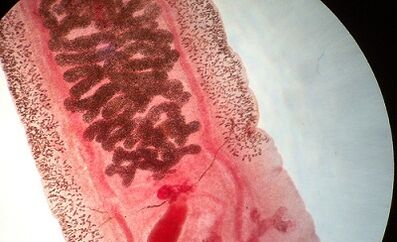
It is a serious misconception among patients that the helmink live only in the gut.However, we cannot deny the fact that human blood parasites are as wide as other types of Helminthians.Identifying and timely therapy for such pathological conditions require special attention, as when it enters the bloodstream, a small substrate can reach absolute any organ.
Symptoms and painful feelings that cause worms in people's blood may be different in both manifestations and their severity.It is important to start treatment on time and prevent the parasites from spreading on the human body in order to prevent complex consequences in time.Initially, you need to know how worms appear in the blood.
Types of parasites by adjusting bloodstream
Nothing is as complicated to produce the right differential diagnosis as the enormous spread of symptoms that appeared in patients with parasites in the blood.Different types of helmits cause different signs.In the case of infection of blood or blood vessels, the patient should perform a complete medical examination, which promotes the identification of the parasite and determining the proper treatment of the pathological condition.
Many parasites are able to live in human blood:
- Babesia;
- Malaria plasmodium;
- Tripanosoma;
- Ankylostoma;
- Trichinella;
- Toxoplasm;
- Tokokara.
Most helmin enters the human body after insect bites.Such parasites of the circulatory channel are the most dangerous for children.These affect the proper development of the organs, the growth of the whole body and the state of the immune system.Many people have been able to live with parasites for years and do not suspect they are infected.
General symptoms of parasite blood poisoning
The symptoms of each type of parasite of human blood are only characterized by this disease.
However, there are many signs of any type of helminthosis:
- weakness;
- dizziness, headache;
- nausea, vomiting;
- It may increase total body temperature;
- It hurts in the limbs and the whole body;
- Attacks of losing awareness are possible.
All these symptoms are the main manifestations of the increased content of toxic substances in the body.During their first appearance, you should contact a medical institution where doctors perform all necessary tests and diagnostic procedures, which most accurately determine the cause of such a state.
Babesiosis: Symptoms, Diagnosis and Treatment
Babesia is small parasites that enter the human body after biting an ixodic tick.These simplest organisms quickly penetrate the erythrocyte membrane and begin their difficult life cycle.The disease is widely used in warm regions where the IXodes clan mites live.
In most cases, the disease occurs without obvious symptoms in both adults and children.
However, when the disease appears and develops further, the characteristic features are noted:
- Hemolytic anemia;
- fever from 39-40 degrees;
- chills;
- Increased sweating.
Similar symptoms occur at the latest 4 weeks after the bite of the tick.After the incubation period, the chances of identifying the disease are much higher.
The disease can only be diagnosed in the conditions of special laboratories.Therefore, there is not so much data on the spread of the disease and its symptoms.
However
- General blood test;
- Serological tests for antibodies against women;
- polymerase chain reaction;
- Microscopic examination of blood smear (painted with hymity).
Treatment is primarily performed with antiprotozoal drugs.The revenue of such funds usually lasts up to 10 days, but may continue in the recurring patients of the disease.Treatment of asymptomatic patients is only performed if the baby is detected in the blood during the analysis, which is performed a few months after the initial detection when the participating disease was recurring.
Tripanosomosis: Symptoms, Diagnosis, Treatment

Tripanosomosis, that is, so -called sleepy disease, is widespread in tropical and subtropical climate countries and is rarely found in moderate width.The cause of the disease is a tripanosome.It's a little parasite.After looking at the parasite photo of the electron microscope, you can distinguish between flagella and membrane throughout the simplest body.
The disease and its symptoms develop in two whole stages.In the first phase, the parasite penetrates human red blood cells and begins active reproduction.
This section can be recognized with the following signs:
- Fever packages for up to 7 days;
- headache, weakness;
- joint pain and limbs;
- severe itching;
- The appearance of red wrinkles in the place of inflamed lymph nodes.
In the second phase of the disease, the tripanosome penetrates the central nervous system on the hematoencephalic barrier.This stage is characterized by severe damage and waking cycle - the main symptom of the disease.
In addition, it may appear in a patient in the second stage of sleepy disease:
- blurred consciousness;
- Muscle trembling, weakness;
- paralyzed limbs;
- apathy;
- irritability;
- Aggression about others.
Treatment should be started as soon as possible, otherwise this is not the most favorable result.As the disease progresses, the disease leads to the appearance of several body system systems at the same time, resulting in the patient's death.
Diagnosis of sleepy disease is based on the patient's symptoms and is based on microbiological examinations of the presence of trigans in the blood, lymph and the purulent fluid taken from the shancra.With positive patterns, treatment is urgently prescribed.
A good prognosis occurs if the disease can be detected in the haemolytic stage.At this time, quite toxic drugs are prescribed, but treatment is usually well tolerated by the patient's body.
However, when the disease is only recognized in the second stage, the prognosis is not always reassuring.Severe, toxic drugs should be used to treat such a pathological condition that can penetrate the protective barrier of the central nervous system.
Malaria: symptoms and treatment

Infection with malaria plasmodium occurs through mosquito bites.Through the female salivary gland, the parasite penetrates into a person's bloodstream, transferred to the liver by blood flow, where the first stages of metamorphosis pass, then enter the bloodstream again and affect the red blood cells.
The incubation period of the disease lasts up to 25 days.Then the first symptoms of malaria are manifested:
- sharp increase in body temperature;
- headache, weakness;
- Hemolytic anemia;
- the jaundice of the skin;
- nausea, vomiting;
- the joints of pain, pain in the whole body;
- seizures;
- The formation of the products of red blood cells in the urine.
Basically, the disease is widespread in hot and hot regions, so diagnosis is based only on the symptoms and history of the patient's life, which manifests itself over time.Frequent travel to equatorial countries can cause the disease.In addition, standard blood tests and microbiological testing of body fluids are performed.
Therapy is prescribed depending on the type and severity of the disease and is primarily used for anti -malaria drugs.
Ankylostomosis: Symptoms, Diagnosis and Treatment
The disease -causing parasites live in the intestinal genes and feed on the blood cells of the master's body.The worms penetrate a person's skin and start migrating to the gut.During the movement around the body, the blood flow parasites fall into the lungs and then pass through the trachea and upper respiratory tract along the bronchi, where they provoke a swallow reflex and thus reach the intestines that are fixed on the wall.
In rare cases, worms worms are unable to successfully complete their migration and remain the skin of a person.In the picture, a similar procedure is similar to small, thin snakes on the patient's skin.

The blood is eaten and worms provoke the development of iron deficiency anemia in infected persons.The most dangerous is when worms penetrate the children's bodies.The lack of iron, protein and other components needed for the development of the child can cause mental retardation, growth retardation and physical inferiority.
Main symptoms of ankylostomosis:
- iron deficiency anemia;
- fever packages;
- pain in the abdomen;
- nausea, vomiting;
- diarrhea, constipation;
- severe body weight loss;
- Coughing and upper respiratory infectious diseases are possible during migration of the parasitic larva stage.
Diagnostic measures, general blood tests, stools and urine analysis, and ultrasound examination of the digestive system can be distinguished.Identification of parasites is a good cause of immediate treatment and preventing the patient's body's breathing, digestive and circulatory systems.
Treatment is carried out with the simultaneous intake of the anthelmintic drug.Therapy is supplemented with vitamin and mineral complexes, allowing the consequences of hemoglobin deficiency to smooth.
Toxocarosis: Symptoms and Treatment
The pathogenic drugs of this disease are the round helmin, which can be obtained after prolonged communication with pets who have not escaped the disinfection when they eat unwashed vegetables and fruits.The human body becomes the intermediate host of the parasite.
Entering the intestine, the larvae emerge from the eggs and begin to "drill" the intestinal wall, penetrating into the bloodstream.With blood flow, the helmints migrate to any system of the human body.The result of the migration of worms is severe damage to the heart, the central nervous system and the visual organs.

Main symptoms of body infection:
- increasing total body temperature;
- the appearance of severe pain;
- weakness, dizziness;
- the appearance of allergic rash on the skin;
- Strong cough at night;
- Cramps, muscles and joint pain.
Diagnosis of the disease is quite difficult.Severe microbiological, allergological tests should be performed that require a special laboratory:
- polymerase chain reaction;
- Immunorbens analysis;
- Serological tests;
- Ultrasound examination of organs;
- Magnetic resonance and computer tomography.
Severe anthelmintic therapy is performed only if the brain is severely damaged, the patient's heart muscle is observed.Very often, the disease depends on its own, as the stage of the larva cannot develop into an adult person in the body of an intermediate host.
However, the damage that migrant worms can cause the patient should be taken into account.Supporting therapy should be carried out and the necessary measures should be taken to prevent severe pathological processes of liver, cardiovascular and other organs.
Conclusion
Any parasite is dangerous to the human body.If questions arise: "what parasites live or use blood as a blood transport system", "how to determine it correctly or not", "how to treat them and what to buy", it is best to contact a parasitologist and not make independent decisions.Treatment and prevention of parasitic diseases is a decision that a qualified doctor should make.



























